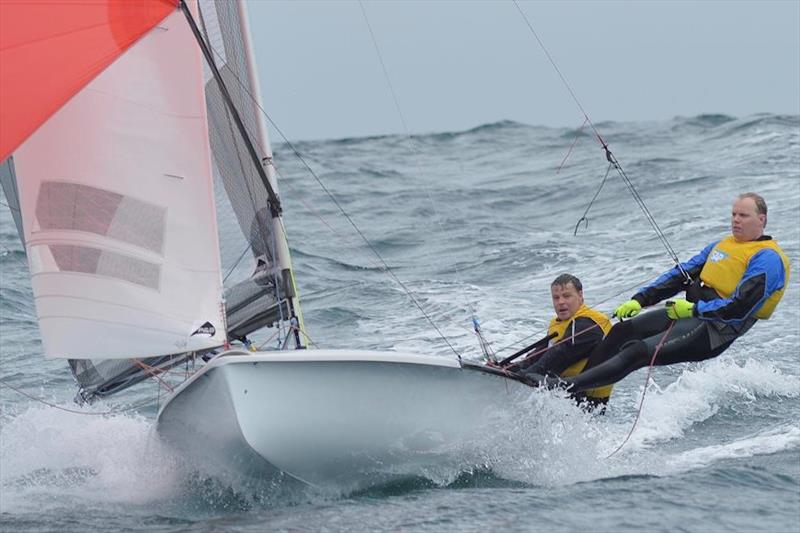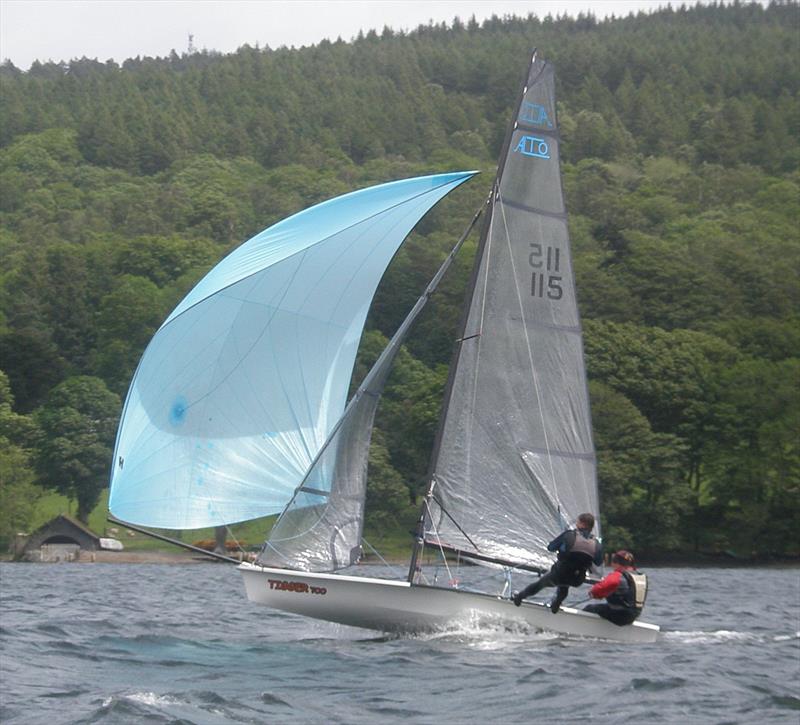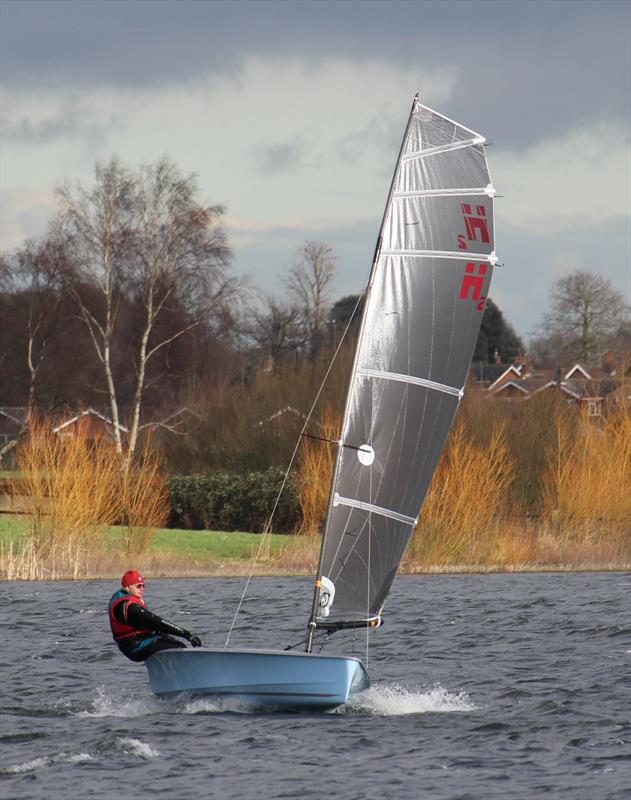
Silver Dream Racer
by Dougal Henshall 30 Mar 2016 15:05 BST
30 March 2016

The evergreen Ian Pinnell should be an inspiration to us all! His is the living proof that dinghy racing, even at the highest level, is remarkably non-ageist! © SAP 505 / Christophe Favreau
When Bob Dylan penned the immortal words "I was older then, but I'm younger than that now" for his 1964 song, 'My Back Pages' he could well have been thinking ahead 50 years to the state of dinghy sailing today. On the face of it, it appears that in recent times that our sport has become dominated, almost to the point of obsession, with a pre-occupation with youth. There is now a Youth Olympics (which includes sailing, at a time when it is being dropped from the Paralympics) and an annual Youth World Championships. Yet a visitor to the recent Dinghy Show who bothered to look at the visiting crowds more than the boats, could easily have drawn the conclusion that far from this being a sport for the aforementioned young, that dinghy sailing is for the middle aged and older!
We should though not forget another great truism; "Youth is wasted on the young". Yet there is now a very real risk that the unblinking focus placed on 'youth' by both the administrators of the sport and major sections of the boating industry could ultimately prove detrimental to the current wellbeing of grassroots activity.

The Joachim Schult book on tactics and strategy quite rightly draws on the similarities with chess
However, in theory, this pre-occupation with youth sailing should not be an issue, as it just so happens that unlike many other sports, dinghy racing is a remarkably non-ageist activity. Moreover, despite the pernicious spread of the Youth Squad System, for now at least the mature sailors remain in the majority, which is just as well, as it is they who are keeping so many of the UK sailing clubs in business! For every speed-skin clad teenage wannabe winner, there is a far larger number of middle-aged sailors, of both sexes, plugging away weekend after weekend with a remarkable degree of commitment, churning their way around the same set of buoys at their local sailing club. A closer look at these activities shows that whilst blasting around in an over-canvassed skiff might be fun, it is just one small part of a much greater and more rewarding activity. The ability to sniff out the next windshift, or make the right tactical choice in order to gain the greatest advantage over your opponents, is a skill that can take years to develop and in truth, is never fully mastered. There is always more to be learnt and for the older sailor, the goal is to be able to do more but with less of an outlay of physical energy. The old adages keep coming, with 'there is no point in getting older if you don't get any wiser' translating neatly into 'sail smarter', a mantra we should all be following. Age can even be an advantage, as the years of experience helps develop that mental perspective that should translate into fewer mistakes being made. Moreover, the successful strategies found in dinghy racing (such as the ability to be thinking 2 or 3 moves ahead) have a strong affinity with the game of chess and it is of little surprise that one of the definitive works on the topic, Joachim Schult's 'Tactics and Strategy in Yacht Racing' features a pair of chess pieces on the front cover.
Although dinghy racing is far more physically demanding than many onlookers would give credit for, at most levels it remains easily achievable for the majority of grass roots sailors. Of course, at the very pinnacle of competition, our International and Olympic stars are athletes in the truest sense of the word, but again, for most club and open meeting level sailors, a day afloat is a good all round work out that certainly ticks all the boxes in the search for that "we must all take more exercise" message. So, on the face of it, dinghy racing rocks! What is more, there is plenty of evidence to show that not only are the oldies still able to sail, but a number of them are doing so a damn sight more successfully than their younger counterparts.
Yet, if dinghy racing is such a good thing, providing both a mental and physical work out, why then are the numbers of people participating so markedly in decline. Sadly, it has become too easy to pick out a few salient headline numbers that seem to suggest that the sport is not only healthy, but getting younger too, but there is a real danger that this could be a case where the statistics are chosen to support the message being promoted. Move away from the 'core', with their preoccupation with the Olympics and 'Yoof' and there are too many other indicators to ignore. In short, the sport is sitting on a demographic time bomb that is counting down towards zero hour! Clearly there are a lot of factors at work here, but the biggest single issue is the rapidly approaching point at which the post war 'baby boomer' generation will reach the end of their sailing shelf life. Those born in the decade immediately following the end of the war really were the golden children, as they made the most of the 1960s and 1970s explosive era in dinghy sailing. A major survey held back then found that the Number 1 aspiration of the so called working man (the survey was supported by a 'red top' newspaper) was to be a boat owner, so it is little wonder that so many of them found their way into dinghy sailing. Now though that golden generation are reaching that point of being past their sell by date. Further evidence of this can be seen in many fleets, where a simple look at the demographic profile highlights this area of concern.
For these sailors, who remain the solid core of the sport and are often the backbone of the club fleet, knees, hips, wrists and back are all started to demand payback for a lifetime of ducking under booms. Add in hiking out, hunching up on the gunwale in a poorly fitting trapeze harness and for those of a certain age, the damage caused by wearing weight jackets (how did the IYRU/ISAF allow that to go on for so long?) and it is an even greater surprise that so many older helms are not only still out afloat, but able to still enjoy their day at the front of the fleet.

In this graph taken from the 2011 Census, it can be seen that there is a pronounced cliff immediately after people in their early 60s - this will impact throughout life, but will have a significant impact on the sailing scene
As can be seen, the worry is that dinghy racing has now been in something of a long, slow decline for almost a quarter of a century, but the demographics warn that this downward trend could be about to get significantly worse. Yet incredibly, this older generation, which could be easily labelled as 'silver sailors', really ought to be at the heart of a much-needed revival in the fortunes of the sport. For unlike the younger generations, these sailors aged 50+ years and older, are far more likely to have both the time and disposable income to spend, that can allow them to indulge their passion for being afloat and, for many, out racing.
However, in accepting the premise that the Silver Sailors still have a huge part to play in the dinghy racing scene, the question remains as to why so many have already deserted the sport? It can hardly be the competing lure of the golf course, for in terms of participation, golf as a sport is facing even greater challenges than sailing! Just taking a view on the position in England, Golf Club membership has declined by 20% in a decade. That iconic sport of the seventies, Squash, is another previously popular sport that has seen a precipitous decline in support. Clearly though age is not a major factor in limiting sporting/physical activity, as at the other end of the participation spectrum is cycling, with numbers up by an estimated 500%! Nor can it be the personal aesthetics, as a late middle-aged member of either sex looks no better in coloured Lycra than they do in coloured neoprene!
Clearly this is a highly complex subject, with many factors impacting on the changing nature of involvement in sport, but it can be seen that one clearly identifiable barrier to the continued presence of the 'Silver Sailors' out on the race course, is the near total lack of boats that are really accessible and tailored to their needs.
Given the already fragmented nature of the UK racing dinghy market, this may seem a strange point to be making, but it is a hard fact that very few of the boats currently available in the UK could really be described as 'Silver Sailor' friendly. That is not to say that there have not been some very good attempts to produce boats that would allow the older sailors to stay actively afloat for longer. More to the point, the same criteria that would make for a better boat for those Silver Sailors would also make for a better boat for everyone. It is important to make clear at this point that no one is suggesting that what the sailing needs is the dinghy-racing equivalent of the Suzuki Wagon R or an invalid carriage. There is no reason at all why the older dinghy sailor should not still enjoy great performance afloat, just as much as any other sailor, indeed it is the lack of performance in the more suitable (but not ideal) boats that is very much at the heart of this issue.
What then is wrong and why are the excellent boats current available missing out on what should be such an attractive market sector?
First and foremost has to be the weighty question of weight! It has long been recognised that the hardest work a sailor has to do is to pull his boat back up to its place in the dinghy park after sailing (the second hardest is to pull it down to the water). What might make a normal sailor puff a little can become a serious consideration for the older sailor. Good wheels on the launching trolley (including a jockey wheel at the front) can help considerably, but a boat weighting in at 50kgs is going to be a whole order of magnitude easier to move on land than one weighing in at 100kg+.
When looking at the single handers, which in Silver Sailor terms are, as elsewhere in the UK dinghy scene, the most buoyant area, this ease of movement becomes even more critical. Although you can always ask for a "bit of a pull", there will always be those times when this is not possible and the sailor is left to his own devices. As already stated, the Silver Sailor may well be time rich; if he wants to go sailing mid-week, being able to easily move the boat around on shore is a serious factor!
The weight issue extends to the rig, for the ease in handling a carbon mast when ashore again highlights the difference between managing and having to struggle. But then, what is the point of building a 50k hull, only to lump a heavy old mast onto it? The whole idea has to be to maximise the benefits of all of the latest technologies, in order to make life easier, afloat and ashore. Having determined that Silver Sailors like an easy life the next criteria would have to be a sail that is hoisted up the mast with a halyard (none of the threading a mast up a sleeve then dropping into a hole malarkey). A key point here is that the reference is to a sail....singular. The Silver Sailors want a boat that they can sail across the full range of conditions which means maybe a more modest sail plan than the current crop of more modern and lightweight boats offers. It ought to be intuitive that if the hull weight is significantly reduced, then the boat needs less in the way of a powerful rig. Yet this is a lesson the boat builders of today seem to have completely ignored, as they blindly follow the misplaced ideal that 'more performance makes for a better boat'. Whilst many would argue that more performance is a good thing and that faster boats are more exciting, it is a hard truth that wind and wave have never given anything away cheaply. The over-provision of sail area, plus the provision of an extra sail, may make for a wonderful boat, but it is one that fewer sailors can happily enjoy without the need of many long hours of practice.
This highlights the need for boats that share more in the ethos of the designs of Jack Holt and Ian Proctor, for these were two designers who clearly understood that the requirement for a successful boat was for one that offered manageable and vice free sailing. The current trend for a range of rigs is a clear indication that once the breeze gets up, the new boats become too much of a handful, which leaves helms needing to change to a smaller rig. Better use of modern technologies, allied to improved hull and rig design ought to be able to result in an easily driven, vice free boat that enjoys an acceptable level of performance whilst not requiring an acre of sail to be set.
Of course, dinghy racing being what it is, there will always be those occasions when something will go wrong, with the result being a capsize. There has been a fair amount of discussion recently about the recoverability of boats and be it the venerable Solo, or one of its newer contemporaries, a centreplate that is a foot above the water level, can be just an insurmountable barrier to recovery. Righting lines can be help, but they are only a partial solution. If the younger helms are finding righting some of the new boats difficult, this can be a serious issue for the Silver Sailor. Another of those old clichés says that it is a dangerous thing to sail a boat that you cannot recover. Yet why are these boats being designed to float so high? Silver Sailors can of course remember the original Mirror 14, which once on its side lay stuck up in the air making recovery a real problem. The answer was simple, with the adoption of 'flooding sidetanks' being an easy retrofit that solved the problem. One has to wonder why other designers do not put more thought into the usability of their boats; maybe it is just considered 'uncool' to take into account what it is really like to live with the boat!
A further physical consideration might be seen by some detractors as the 'armchair and slippers' moment, but in all truth, comfort is important. Kneeling on the cockpit floor whilst sailing downwind is just a non-starter; fit a thwart. Ditto a shallow cockpit, that leaves the knees up under the chin, is another turn off for the older sailor. There needs to be enough depth in the hull so that tired knees are not over taxed, ergonomically designed side decks so that sitting out is facilitated, with plenty of flare in the hull form so that the righting power is there without having to hike like a teenage Laser sailor.
At the same time the boom needs to be high enough to allow for easy tacking; it may not have to be so high as to allow a 'walk through' but neither should it be so low as to require the limbo dance antics seen in the Contender!
The two final considerations might well finally end up as personal choice. Certainly layout of the control lines should be left open, allowing for a degree of flexibility, though this should be kept within reason, for few would want to be bothered with the string-fest found in some of the traditional classes. The Silver Sailor might well be something of a tweaker and 'boat bimbler' who has a penchant for Allen fittings rather than Ronstan, but he is unlikely to want the constant upkeep of the 'everything adjustable' concept. This also highlights the final design and build consideration, in that the boat needs to be aesthetically pleasing to the eye. Given that the Silver Sailor can probably afford what he wants, there is likely to be a far greater degree of 'pride of ownership' in whichever boat is chosen. Younger sailors may happily chop and change their classes, with their boats becoming something of a commodity item, but in all probability the Silver Surfer will have come from a class where he has spent a significant number of years. Despite the potential problems of age, the Silver Sailor will view the boat as something to be cherished and fussed over, a boat to be looked at with pride.
Clearly these criteria, weight, vice free handling ashore and afloat, comfortable, ergonomically sound, easily recoverable and at the same time, beautiful looking ought to be already in the minds of designer today and in some ways they may be. There have been some interesting, at times verging on the radical designs, that have already come close to ticking all the boxes, but have sadly just fallen short.

A simple and easily achievable route to really high performance, the Alto is a superb example of a boat that ticks all the boxes for the Silver Sailor - photo © M Arnold / Alto Class
The first of these fits neatly into the performance dinghy category, which might well, be a surprise location for the Silver Sailor, but then, why not! Mike Arnold would certainly meet the terms of being a Silver Sailor himself and he certainly recognised many of the conditions described above with his Alto dinghy.
As an ex-front runner in the 505 class, Mike knew a great deal about what made for a good performance boat, yet at the same time he could see that the cost and complexity of the FiveO was now working against its greater popularity. Taking the 505 hull shape as his starting point, Mike set about creating a boat that retained all the positives, yet with an easy to use simplicity. The hull was kept single bottomed for helm comfort, whilst the self-tacking jib and gnav kept the front half of the cockpit area uncluttered for the crew. If there was a complexity about the boat it was with the swinging pole system for the asymmetric, but the gains from having this appeared to outweigh the addition of another set of control lines. Having gone for the single bottomed layout, this then proved an additional bonus, as once capsized, the boat lay docilely on its side, with the centre-plate almost level with the water.
Out afloat, the Alto proved that it could deliver genuine performance sailing without demanding too much from the crew and with a fraction of the complexity of many competing boats. On the face of it, the excellent Alto ought to have been a winner, even more so when it got the high profile backing from P&B, yet somehow this innovative and accessible boat failed to attract a critical mass of owners. In hindsight, it may well have been a clear-cut case of the right boat at the wrong time. As the Alto was being launched, performance boat sailing was taking a crippling hit, with all of the mainstream classes seeing a reduction in numbers whilst in the UK, even the internationally recognised 505 was haemorrhaging support.
In many ways the two person hiking dinghy sector should have been an easier target to aim for, given that two of the core RS boats, the 400 and 200, had already shown the possibility of creating new niches in the market. Although almost a half century younger than many of the existing boats in this genre, the RS boats showed quite a strong conservatism in their packaging, which would rule against either being a boat for the Silver Sailor. Instead, it was Mike Lyons, who had established his reputation when he took the unloved Blaze and turned it into an enjoyable and thoroughly able performer, who would come closest to creating a truly modern boat. Just as Mike Arnold had used the 505 as the donor for the Alto, so Mike Lyons would go to the NS 14 as the basis for his Icon dinghy.
Aware of the strength of the RS boats in this sector (not to mention the GP14, Scorpion, Lark and Merlin Rocket) Mike Lyons kept the Icon deliberately simple; the lightweight, easily driven hull was powered by just a main and jib, albeit with the foresail controlled by the easy to use 'dangly pole'. Yet despite not having a spinnaker, the advanced rig on the Icon gave it a wonderful turn of speed offwind, without any of the angst and complexity that can go with the third sail. For the populist pastime of 'round the cans' racing, when legs can often be short and not broad enough for spinnakers, the Icon can be a very accomplished club level performer. Like the Alto, the Icon came incredibly close to ticking all the boxes and thus having the Silver Sailors queuing up to sail it, yet a few simple issues seemed determined to trip up its success. For a start, the race pedigree of the NS14 has resulted in a lean and fairly shallow hull that some found uncomfortable to use. The addition of an optional thwart solved some of the issues but in Silver Sailor terms, the Icon remains a 'very near miss'.
Meanwhile, there is word of yet another entrant into this highly competitive sector, but at this point there is no detail as to how the boat will look. It will certainly be light for its size, is rumoured to be a 'weight carrier' and should slot neatly into the two person-hiking genre and hopefully will tick enough boxes for the Silver Sailors to make it a success.
New boats are also highly prominent in the ever-growing single-handed dinghy scene. Here, the large number of the existing classes have been joined by some superb new entrants with boats such as the RS Aero and Devoti D-Zero quickly establishing their credentials as exciting boats for the future. Yet even these wonderful new designs tick some, but sadly not all of the boxes. Given the high quality of design that has been put into these new entrants, this does highlight just how difficult it is for the result to be a really 'good' boat. Luckily though, as was seen recently in the 'Radical thought' article, designers have now clearly started to recognise that yet another old sailing soundbite, that "weight is only of value in a steamroller" is true. Yet despite these innovative designs and some near radical levels of hull-weight management, the boat that may end up ticking most of the boxes is yet another instance of revisiting a hull design that had earlier been successful. Back in the early 1970s, designer Keith Callaghan developed the Harrier dinghy for the father of top sailor Lawrie Smith. Harold Smith was then an OK sailor, but was finding that he was getting too old for the boat and wanted something that would keep him sailing, so in many ways the Harrier can be seen as a boat designed with the Silver Sailor in mind.

It can be done! State of the art construction techniques equate to a lightweight hull, a modern rig makes for a boat that is sailable across the wind range and good design does the rest! - photo © Keith Callaghan
With his extensive background in designing Merlin Rockets (indeed, Keith is the longest serving designer in the history of the class) it was little wonder that the hull shape of the Harrier bore a striking resemblance to that of a Merlin Rocket. The build techniques back then resulted in a hull that despite being heavy, could go soft, yet even so the boat enjoyed reasonable success before being swept away by the Laser phenomena. Then, a few years ago, wanting to get fit enough to crew in a Merlin again at Salcombe week, Keith went back to the original idea of the Harrier and brought it up to date with his design for the original Hadron.
Well-mannered afloat, comfortable to sail, easy to recover following a capsize, the Hadron ticked many of the boxes for the Silver Sailor boxes. Nor is it just the boat for the older sailor, as when Tom Gruitt tested the boat for Y&Y, his report highlighted the handling and comfort of the boat, yet with performance to "put a smile on your face". The latest news is that with the lessons learned with the Hadron, Keith has taken the concept a stage further by developing a sleeker version of the boat, the H2. Using the latest in build techniques with carbon/aramid construction, the hull is both light and stiff, yet delivers the ergonomically sound design that will make the H2 a delight to sail, whatever the age of the sailor. Yet another of the truisms is that there is very little that is really new, so when Keith observed how high some of the new boats float when capsized, he redistributed the buoyancy and then adopted the 'flooding side tanks' as seen in the Mirror 14. The result is that when capsized, the H2 floats with the boat level with the water, with the boat showing less of the modern inclination to rapidly invert.
Whilst accepting that the primary theme of this article has been focused on the needs of the Silver Sailor, as was said earlier, the needs of the older helms will translate equally into boats that all can enjoy! The Alto, Icon and Hadron are all showing a clear line of thinking that the RS Aero and Devoti D-Zero have already taken a stage further. If sailing is going to reverse some of these downward trends, then there needs to be something of a radical rethink. The new materials and construction techniques are capable of building boats that could be between 30% and 50% lighter than the existing 'stock', which results in the near ludicrous situation of having to 'build boats heavy', then add in slabs of lead corrector weights. The Supernova class was one who recognised this situation, with builders Hartley Boats taking the 'radical' (at least in terms of an already established class) step when they dieted 20% of the hull weight away in producing the Mark 2 boat. Dire warnings of the potential demise of the class have proved to be unfounded, as in losing weight, the Supernova has gained support.
As a sport, there is a very real danger that dinghy racing is blindly heading towards that demographic cliff edge, with there being little in the way of any strategy to soften the impact that will follow. Doing nothing is not an answer and where nothing is done, classes (and clubs too) are going to struggle. Keeping the Silver Sailors active for another five, maybe ten years is not going to change the overall direction of the sport, yet this could be a crucial factor in buying sufficient time that will allow the new breed of boats to attract sufficient support, whilst enabling clubs to reshape themselves for the future. By then, the next generational bulge will be becoming Silver Sailors, for there is one factor that no one can deny; looking to the future, there are going to be more and more older people. Boat builders, clubs and those who administer our sport will ignore them at their peril!